We were told by our hosts at IPM , even before we left home, that Iranians love music. Their musical history goes back to the 5th century B.C. and Iranian scolars and musicians have traced and developed the music throughout their history. It was mostly used for prayer, ceremony, religious musical theater. Starting in the 17th century their music began to be performed at royal court festivities, and at private parties. As in European culture, noble families considered it important that children be trained in musical skills. In the 19th and 20th century music flourished, the media allowed more Iranians to be exposed to classical music, their own and Western, and students graduated from music schools in the West, and added much to their country's musical life. Female vocalists were allowed to sing in public. As more popular music infiltrated into the mainstream culture, Persian classical musicians kept their tradition alive, mostly in private. In 1979 the Islamic revolution brought a complete halt to musical activity. Only revolutionary songs were permitted. Many musicians left the country or stayed in their houses. Soon however, the Islamic regime broke ties with the Shiite clerics for the first time, since the advent of Islam in Iran, and the trade of musical instruments began again to flourish! Now, students again attend music school in Iran, and children carry instruments on the streets. While 'pop' music is still considered disrespectful, classical Persian music is encouraged. It will be interesting follow this new development in musical freedom. The conference activities included a concert of traditional Iranian music and the IPM's "Daily News" had articles explaining the nuances of structure and history.
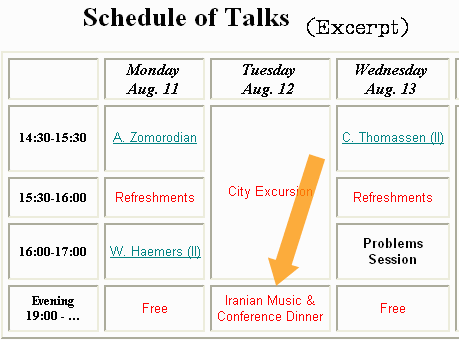
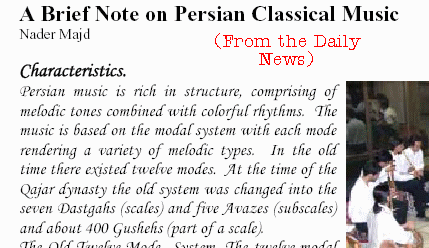
A PRIVATE CONCERT — Rick was asked to play at a party at the home of the Associate Director and Head of the School of Mathematics at IPM, Reza Khosrovshahi. Rick said he would play only if he was asked three times, and this requirement was soon met. Rick played the beautiful 'Roslyn Castle' Nicholson's 1821 arrangement of a Scottish air. Rick played on a circa 1870 Euler 9 key flute that he had decided was a good traveler. The piece met with happy approval, and the floating melody seemed somehow Persian... In the Scottish 'Banks of Doon' with words by Robert Burns, Kathy's voice blended with Rick's Folker's and Powell baroque (one key) flute copy. Also the 'Yew Tree,' another Scottish song spoke to all, questioning 'what the future would hold'.
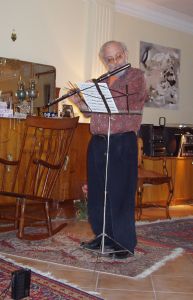

After that, Reza's son played a large tambourin-like Persian drum. It was a dramatic solo, as well as an athletic feat. The huge, heavy instrument is thrown several inches occasionally while being played, keeping its position, but giving a different sound effect and rythmic emphasis. It is usually played in groups but he willingly demonstrated with panashe.

And that was followed by Peter Cameron, Professor of Mathematics in the School of Mathematical Sciences at Queen Mary, University of London, another 'keynote' invited speaker, who accompanied himself on a guitar that happened to be there at the house, as he did Beatles and Simon and Garfunkel songs, which were greatly appreciated by everyone.

A CONCERT OF TRADITIONAL PERSIAN CLASSICAL MUSIC — The formal entertainment the next evening (Tuesday) was a public concert at the IPM
It was 'Persian Classical Music' performed by a group of 12 young men. There was a hammered dulcimer-like
instrument, four setars (plucked strings), four kamanchehs (bowed strings),
a drummer, and a ney player. The singing was particularly
fine and interesting, with distinct and intricate ornaments.
we enjoyed the times when an instrument was allowed a solo more
than the large group efforts.

Rick asked how old the music they played was. To his ears, it sounded rather medieval. But what they did was music from the 19th century and some modern works in that style, they said. Hmmm. It makes one wonder whether some early music groups that attempt to recover and perform in a medieval style aren't coming closer to 19th century Persian music than to 14th century Western music.
Many young people have taken up traditional Iranian instruments. There may be encouragement from the government, to wean the people off of Western music. (But there is no danger of that.) This is the concert setting, on the first floor of the IPM building. The centerpiece is an abstract sculpture seen from an upper floor (photo by IPM).

AFTER THE PERSIAN CONCERT, RICK PLAYS ONE WESTERN CLASSICAL PIECE — Rick had been asked to play after they finished. (Women, currently, are not supposed to sing or dance in public, and Kathy doing percussion was also ruled out.) This was disappointing, but we didn't want to do a lot after a full concert anyway, so Rick did only a Theme and Variations by Anton Hoffmeister (1790's) on a one-key flute. Only four of the variations, without repeats, for a total of less than five minutes. This was a good choice; just the right length and spirit!

The Persian musicians liked it too, and some crowded around Rick to talk. One said he admired the drone-like accompaniment in the variations.

The ney player said he could get Rick a ney from one of the best makers, but the maker was in Isfahan, where the ney player lives. Coincidently, WE were going to be in Isfahan, and an arrangement was made to meet. We were not absolutely sure that this was going to happen, however.
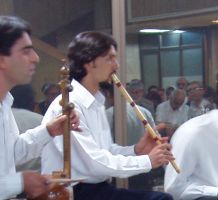
ANOTHER PRIVATE CONCERT — Rick played again in the home of Shahriar Shahriari's inlaws. Shahriar as an organizer and invited speaker at the conference, whose wife's family lives in Tehran. He is a Professor of Mathematics at Pomona College in California. Here Rick's intent listener is our host at IPM (Associate Director and Head of the School of Mathematics) Reza Khosrovshahi. He enjoyed Rick's performance of a piece by Friedrich Kuhlau (1792-1833) followed by some klezmer music. This was a private home so again we were able to perform together. Kathy played a plastic watercolor box (her imprivisatory small drum) and danced in accompaniment to the hora and freylach. An Iranian guest who had spent time in the US, played classical works on the guitar, and then Simon and Garfunkel. Peter Cameron, Professor of Mathematics (University of London) continued with more Simon and Garfunkel as well as an old folk song, and more Beatles.
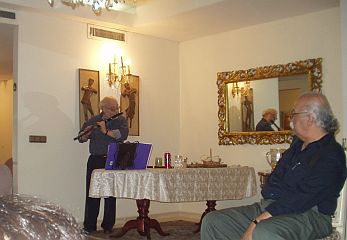
WE BUY A NEY — On Thursday, at a small outdoor bazaar near the IPM, Rick bought a handsome ney. It turned out that we did get a ney later in Isfahan, and this one we gave as a gift to Philippe Allain-Dupre, who put us up in Paris. It was hard to part with it (see the photos in our forthcoming Paris web pages), but it has a good home.
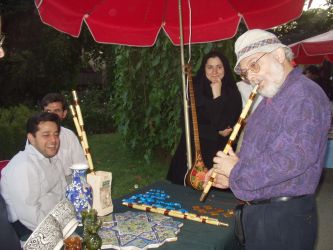
A GIFT OF A NEY — During the afternoon break on Saturday, our friend the ney player, Majid Rahmenema, came to our hotel in Isfahan, with a new ney, still wet from oil. This one was decorated with a depiction of a famous Iranian poet and had finger holes burnt, not cut, into the the reed. He insisted it was a gift! We did not want to accept, although his explanation 'It is the gift of one flute player to another' was moving.(When we had talked originally, $125 was mentioned.) Shahriar and Reza, our IPM hosts, argued with him. We think they will give something to him and pretend the ney is a gift from the IPM. On the right is Reza Khosrovshahi, Associate Director of IPM and Head of School of Mathematics. He loves music!
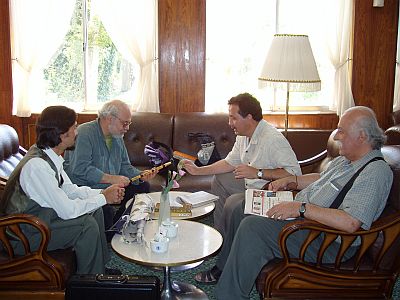
A NEY LESSON — Majid insisted on giving Rick a free lesson in our hotel room as well. The ney is an end blown flute. An edge of the metal ring on the open end is to be positioned between the two front teeth. Rick could not make a sound on it. We were told that it is better to have some space between the teeth. It was suggested that practice would cause or improve this, or else surgery would help. We are not sure that our dentist would approve.
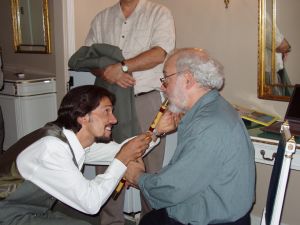
GO TO IRAN TRIP index page